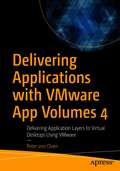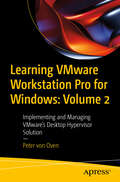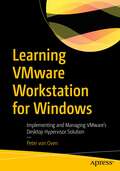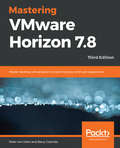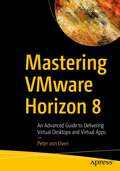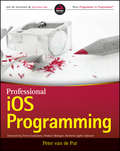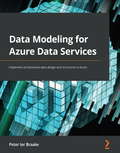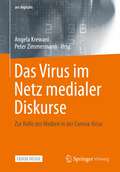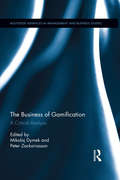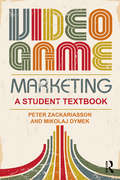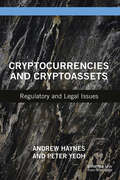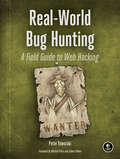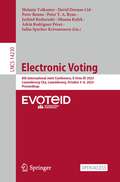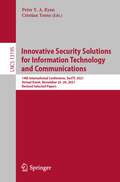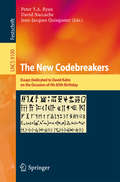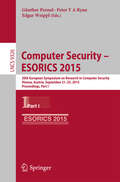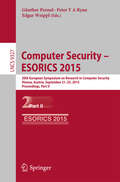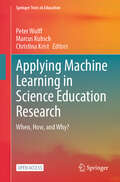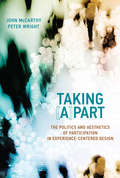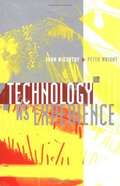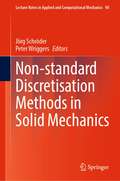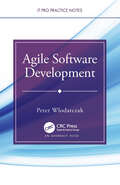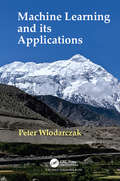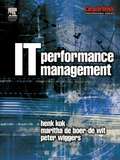- Table View
- List View
Delivering Applications with VMware App Volumes 4: Delivering Application Layers to Virtual Desktops Using VMware
by Peter von OvenAcquire the skills to build an App Volumes environment for a proof of concept, a pilot, or a live production environment. Delivering Applications with VMware App Volumes 4 starts with an in-depth overview of where the solution fits within the market and its key features, introducing you to application layering and VMware App Volumes. Next, it explains how to install the software and use its management consoles to configure App Volumes. You will understand how to build and configure application layers for delivery and will learn to build and configure writeable volumes for user data and user-installed applications. In the advanced management section, you will learn to customize package templates and integrate App Volumes with JMP. Along the way you will understand how to deliver published apps in MS RemoteApp using layered apps for scalability. In the next phase of the book you will install and configure App Volumes for different use cases: VMware Horizon View, VMware ThinApp, Microsoft RDSH, and Citrix Virtual Apps and Desktops. Throughout the chapters, you will be given hints and tips, along with best practices, all seen from the eyes of somebody who works with this technology day in, day out, and in many different types of environments and scenarios. What You Will Learn Understand the App Volumes architecture Master the concept of application layeringWork with App Volumes, application packages, and Writable Volumes Who This Book Is For VMware professionals, system integrators, IT professionals, and consultants.
Learning VMware Workstation Pro for Windows: Implementing and Managing VMware’s Desktop Hypervisor Solution
by Peter von OvenVMware Workstation is a software solution that provides a type-2 hypervisor, or desktop hypervisor, that runs on x64 Windows and Linux-based operating systems. It enables users to create and run virtual machines, containers, and Kubernetes clusters simultaneously on their physical devices without having to reformat or dual-boot the underlying device. There are several use cases for VMware Workstation. For IT pros, it allows them to test applications and operating system builds, as well as enable remote control of vSphere datacenter infrastructure. Developers can run multiple different operating systems or different versions of operating systems on a single device giving them the platform flexibility to test, develop, and troubleshoot applications cost-effectively. Finally, for the greater workforce, VMware Workstation can enable BYOD device initiatives allowing employees to run a full corporate environment on their device without deleting or reformatting it. Learning VMware Workstation Pro for Windows – Part 2 provides the reader with a practical, step-by-step guide to creating and managing virtual machines using VMware Workstation, starting with an overview of hypervisors and desktop hypervisors. Next, it talks about each resource, such as CPU, memory, and networking, and how these are configured in a virtual environment. After that, it demonstrates the installation of VMware Workstation, configuration, and then building and managing different virtual machines running on different operating systems such as ChromeOS, and Linux, and building an ESXi lab environment. Towards the end, readers will learn how to use command line tools, such as the REST API, and vmrun, before going on to discuss upgrading and troubleshooting your VMware Workstation environment. By the end of this book, readers will have full knowledge of VMware Workstation Pro. This book is a continuation of " Learning VMware Workstation Pro for Windows – Part 1 " where readers learn how to build and manage different virtual machines running on different operating systems and build an ESXi lab environment with VMware Workstation. You Will: Learn how to run containers on a VMware workstation Understand how to use the command line to configure and control Workstation Pro and virtual machines Practice the use of REST API for Workstation Pro This book is for: Developers, IT professionals, VMware certified professionals both remote and Bring your device (BYOD).
Learning VMware Workstation for Windows: Implementing and Managing VMware’s Desktop Hypervisor Solution
by Peter von OvenMaster VMware Workstation to create and run virtual machines, containers, and Kubernetes clusters simultaneously on physical devices without having to reformat or dual boot the underlying device. This book provides a practical, step-by-step guide to creating and managing virtual machines using VMware Workstation, a software solution that provides a type-2 hypervisor, or desktop hypervisor, that runs on x64 Windows and Linux-based operating systems. This book focuses on the Windows version.You’ll start with an overview of hypervisors and desktop hypervisors. You'll then look at resources, such as CPU, memory, and networking, and how they are configured in a virtual environment. In the final chapters, you’ll learn how to configure Workstation Pro to run and manage virtual machines before going on to build example virtual machines, including how to build a nested vSphere environment. Once built you’ll see how to manage these virtual machines, before finally upgrading your VMware Workstation Pro environment. In the end, you’ll learn how to build and manage different virtual machines running on different operating systems and build an ESXi lab environment with VMware Workstation. What You'll Learn Examine hypervisors and desktop hypervisorsUnderstand how to install and configure VMware WorkstationGain practical knowledge on building and managing virtual machines on different OSsSupport and troubleshoot VMware Workstation environments. Who This Book Is For Developers, IT professionals that remote, home, and BYOD
Mastering VMware Horizon 7.5 - Third Edition: Master desktop virtualization to optimize your end user experience, 3rd Edition
by Peter von OvenThis book is ideal for system admins, and solution architects interested in gaining hands-on experience with virtualization. It will take you to an advanced level, but at a pace that ensures you re always solving real-world problems. Some experience in desktop management using Windows and Microsoft Office, and familiarity with Active Directory, SQL, Windows Remote Desktop Session Hosting, and VMware vSphere technology is necessary.
Mastering VMware Horizon 8: An Advanced Guide to Delivering Virtual Desktops and Virtual Apps
by Peter von OvenLearn all about designing, installing, configuring, and managing VMware Horizon, with a core focus on how to deliver virtual desktops using Horizon. This book allows you to follow the complete process for deploying VMware Horizon and covers the design, deployment, and management of solutions. You'll start by reviewing remote solutions, from virtual desktops to published applications, including the benefits and what the different solutions deliver. Once through the high-level technology you'll then look at the VMware Horizon solution focusing on the architecture and the components that make up the solution and how to design a production-ready environment. Other VMware EUC technologies that complement the core Horizon solution will also be incorporate into it. Armed with the knowledge of how to design a solution, you'll move onto the installation phase and start to build a test lab environment. Once your lab is installed, you'll move onto the configuration stage where you will understand how to build, configure, and optimize virtual desktops, and desktop pools ready for end-users to use. As part of this you will also look at delivering published applications with Horizon Apps. With resources built and configured you can optimize the end-user experience with Horizon clients. The final sections of the book will focus on the other complementary solutions introducing you to VMware App Volumes and VMware Dynamic Environment Manager before finishing with how to manage the solution where we will look at some advanced configuration options and troubleshooting techniques.What You Will LearnSee the core components of VMware Horizon and their functionalityDesign and install a Horizon environmentDeliver the best end-user experienceManage the deployed solutionUse VMware reference architectures to create real-life scenario examplesReview the minimum requirements for designing a solution Who This Book Is For VMware professionals, system integrators, IT professionals, and consultants.
Economics and the Environment
by Peter van de PutHands-on guidance for programming the next generation of iOS apps If you want to create advanced level iOS apps that get noticed in the App Store, start with this expert book. Written by an international software developer and consultant who has delivered winning solutions for clients all over the world, this professional guide helps you build robust, professional iOS apps at a level that satisfies the demands of clients, companies, and your own creativity. The book includes full source code and invaluable insight from the author's extensive experience. Especially helpful are numerous case studies that shed light on key topics. Explores all topics necessary to help you build professional iOS applications perfectly targeted to clients' needs Covers essential topics including creating a professional UI, networking and data processing, integrating your app, and taking it into production Includes sample code and sample apps, ideal for hands-on learning Examines using social media aggregators, real-time currency converters, QR scanners, customer tracking and quality payment system Provides in-depth examples from the author's extensive career, as well as numerous case studies Take your programming skills to an advanced level with Professional iOS Programming.
Data Modeling for Azure Data Services: Implement professional data design and structures in Azure
by Peter ter BraakeChoose the right Azure data service and correct model design for successful implementation of your data model with the help of this hands-on guideKey FeaturesDesign a cost-effective, performant, and scalable database in AzureChoose and implement the most suitable design for a databaseDiscover how your database can scale with growing data volumes, concurrent users, and query complexityBook DescriptionData is at the heart of all applications and forms the foundation of modern data-driven businesses. With the multitude of data-related use cases and the availability of different data services, choosing the right service and implementing the right design becomes paramount to successful implementation. Data Modeling for Azure Data Services starts with an introduction to databases, entity analysis, and normalizing data. The book then shows you how to design a NoSQL database for optimal performance and scalability and covers how to provision and implement Azure SQL DB, Azure Cosmos DB, and Azure Synapse SQL Pool. As you progress through the chapters, you'll learn about data analytics, Azure Data Lake, and Azure SQL Data Warehouse and explore dimensional modeling, data vault modeling, along with designing and implementing a Data Lake using Azure Storage. You'll also learn how to implement ETL with Azure Data Factory. By the end of this book, you'll have a solid understanding of which Azure data services are the best fit for your model and how to implement the best design for your solution.What you will learnModel relational database using normalization, dimensional, or Data Vault modelingProvision and implement Azure SQL DB and Azure Synapse SQL PoolsDiscover how to model a Data Lake and implement it using Azure StorageModel a NoSQL database and provision and implement an Azure Cosmos DBUse Azure Data Factory to implement ETL/ELT processesCreate a star schema model using dimensional modelingWho this book is forThis book is for business intelligence developers and consultants who work on (modern) cloud data warehousing and design and implement databases. Beginner-level knowledge of cloud data management is expected.
Das Virus im Netz medialer Diskurse: Zur Rolle der Medien in der Corona-Krise (ars digitalis)
by Peter Zimmermann Angela KrewaniDie Corona-Krise gewinnt durch die digital-mediale Verbreitung eine beunruhigende Präsenz, der sich niemand entziehen kann. Dabei handelt es sich nicht nur um die aktuelle journalistische Berichterstattung, sondern auch um das Netz der digitalen Kommunikationen, die das Virus in verschiedenen ästhetischen Formen repräsentieren und reflektieren. Eine wichtige Rolle spielen dabei die Visualisierungen der Pandemie vom allzeit präsenten Ikon des Virus bis zu den Datengrafiken der Durchseuchung. Mit diesen Mitteln entwickelt sich ein visuelles Regime, das wiederum in die mediale Berichterstattung und die Pandemie-Kommunikation zurückwirkt.Damit reagiert das Buch auf die aktuelle Pandemie und bietet eine breitgefächerte Aufarbeitung der unterschiedlichen medialen Repräsentationen des Virus.Das Buch vertritt einen dezidiert digital-medienwissenschaftlichen Ansatz, der die Medialität des Virus und der kontroversen Diskurse der Pandemie mit ihren komplexen und heterogenen Aspekten dokumentiert und analysiert. Damit unterscheidet es sich signifikant von stärker publizistischen oder soziologisch ausgerichteten Studien.
The Business of Gamification: A Critical Analysis (Routledge Advances in Management and Business Studies)
by Peter Zackariasson Mikolaj DymekAt the turn of the century the term "gamification" was introduced as a concept to understand the process of using game mechanics in "non-game" contexts. The impact of gamification was soon evident to business practices where it had impact both on marketing and, more broadly, on the organizations themselves. As the number of individuals playing video games grows, there seem to be an acceptance of game mechanics elsewhere. Its effectiveness is highly dependent on both technical possibilities and cultural acceptance, two factors present today. The aim of The Business of Gamification is to critically analyze the practical and theoretical consequences of gamification. Practically, how has gamification been applied in businesses to this point, and what are the future scenarios? Theoretically, what are the contributions of gamification to existing academic knowledge? How does this change our understanding of how business are performing and its consequences, for organizations, consumers, and society in general? This edited volume contains new, and stringent, perspectives on how gamification is contextualized in business settings, both in theory as well as in practice. This book will provide a wealth of research for individuals seriously interested in the industry at the academic level. As a result, this book will serve as a reference in curricula associated with video game development for years to come.
Video Game Marketing: A student textbook
by Peter Zackariasson Mikolaj DymekThe video game industry has been one of the fastest-growing cultural phenomena of our times with market conditions that demand a specific skill set from its marketers. To a new generation of "indie gamers", being a game developer isn’t just about design and production, a successful video game demands entrepreneurial skills and astute business acumen. The creators need to know what their customers want, how to reach those customers and how to sell to them. Video Game Marketing: A student textbook is for development students or aspiring developers who want to know how to promote and sell the results of their efforts. This book is a much-needed guide to: • the essentials of marketing strategy; • video games as products or services; • marketing research for game development; • branding video games; • marketing through game: gamification, advergames. Replete with pedagogy to aid learning such as objectives and discussion questions for each chapter, this book is all that aspiring video game developers will need to unleash the potential of their games.
The War Against the BBC: How an Unprecedented Combination of Hostile Forces Is Destroying Britain's Greatest Cultural Institution... And Why You Should Care
by Patrick Barwise Peter YorkThere's a war on against the BBC. It is under threat as never before. And if we lose it, we won't get it back.The BBC is our most important cultural institution, our best-value entertainment provider, and the global face of Britain. It's our most trusted news source in a world of divisive disinformation. But it is facing relentless attacks by powerful commercial and political enemies, including deep funding cuts - much deeper than most people realise - with imminent further cuts threatened. This book busts the myths about the BBC and shows us how we can save it, before it's too late.
Cryptocurrencies and Cryptoassets: Regulatory and Legal Issues
by Andrew Haynes Peter YeohThis book examines the legal and regulatory aspects of cryptocurrency and blockchain and the emerging practical issues that these issues involve. The analysis covers a range of advanced economies across the world, in America, Europe and Asia. The book describes, explains and analyses the nature of cryptocurrencies and the blockchain systems they are constructed on in these major world economies and considers relevant law and regulation and their shortcomings. It will be of use and interest to academics, lawyers, regulators and anyone involved with cryptocurrencies and blockchain.
Real-World Bug Hunting: A Field Guide to Web Hacking
by Peter YaworskiLearn how people break websites and how you can, too. Real-World Bug Hunting is the premier field guide to finding software bugs. Whether you're a cyber-security beginner who wants to make the internet safer or a seasoned developer who wants to write secure code, ethical hacker Peter Yaworski will show you how it's done. You'll learn about the most common types of bugs like cross-site scripting, insecure direct object references, and server-side request forgery. Using real-life case studies of rewarded vulnerabilities from applications like Twitter, Facebook, Google, and Uber, you'll see how hackers manage to invoke race conditions while transferring money, use URL parameter to cause users to like unintended tweets, and more.Each chapter introduces a vulnerability type accompanied by a series of actual reported bug bounties. The book's collection of tales from the field will teach you how attackers trick users into giving away their sensitive information and how sites may reveal their vulnerabilities to savvy users. You'll even learn how you could turn your challenging new hobby into a successful career. You'll learn:How the internet works and basic web hacking conceptsHow attackers compromise websitesHow to identify functionality commonly associated with vulnerabilitiesHow to find bug bounty programs and submit effective vulnerability reportsReal-World Bug Hunting is a fascinating soup-to-nuts primer on web security vulnerabilities, filled with stories from the trenches and practical wisdom. With your new understanding of site security and weaknesses, you can help make the web a safer place--and profit while you're at it.
Electronic Voting: 8th International Joint Conference, E-Vote-ID 2023, Luxembourg City, Luxembourg, October 3–6, 2023, Proceedings (Lecture Notes in Computer Science #14230)
by Peter Y. A. Ryan Melanie Volkamer David Duenas-Cid Oksana Kulyk Peter Rønne Jurlind Budurushi Adrià Rodriguez Pérez Iuliia Spycher-KrivonosovaThis open access book constitutes the proceedings of the 8th International Joint Conference on Electronic Voting held in Luxemburg in October 2023. The conference collected the most relevant debates on the development of Electronic Voting, from aspects relating to security and usability through to practical experiences and applications of voting systems, also including legal, social, or political aspects, amongst others. The 9 full papers presented were carefully reviewed and selected from 38 submissions. The selected papers cover a wide range of topics connected with electronic voting, including experiences and revisions of the actual uses of E-voting systems and corresponding processes in elections.
Innovative Security Solutions for Information Technology and Communications: 14th International Conference, SecITC 2021, Virtual Event, November 25–26, 2021, Revised Selected Papers (Lecture Notes in Computer Science #13195)
by Peter Y. A. Ryan Cristian TomaThis book constitutes revised selected papers from the thoroughly refereed conference proceedings of the 14th International Conference on Innovative Security Solutions for Information Technology and Communications, SecITC 2021, which was held virtually in November 2021.The 22 full papers included in this book were carefully reviewed and selected from 40 submissions. They deal with emergent topics in security and privacy from different communities.
The New Codebreakers
by David Naccache Peter Y. A. Ryan Jean-Jacques QuisquaterThis Festschrift volume is published in honor of David Kahn and is the outcome of a Fest held in Luxembourg in 2010 on the occasion of David Kahn's 80th birthday. The title of this books leans on the title of a serious history of cryptology named "The Codebreakers", written by David Kahn and published in 1967. This book contains 35 talks dealing with cryptography as a whole. They are organized in topical section named: history; technology - past, present, future; efficient cryptographic implementations; treachery and perfidy; information security; cryptanalysis; side-channel attacks; randomness embedded system security; public-key cryptography; and models and protocols.
Computer Security -- ESORICS 2015: 20th European Symposium on Research in Computer Security, Vienna, Austria, September 21-25, 2015, Proceedings, Part I (Lecture Notes in Computer Science #9326)
by Edgar Weippl Günther Pernul Peter Y A RyanThe two-volume set, LNCS 9326 and LNCS 9327 constitutes the refereed proceedings of the 20th European Symposium on Research in Computer Security, ESORICS 2015, held in Vienna, Austria, in September 2015. The 59 revised full papers presented were carefully reviewed and selected from 298 submissions. The papers address issues such as networks and Web security; system security; crypto application and attacks; risk analysis; privacy; cloud security; protocols and attribute-based encryption; code analysis and side-channels; detection and monitoring; authentication; policies; and applied security.
Computer Security -- ESORICS 2015: 20th European Symposium on Research in Computer Security, Vienna, Austria, September 21-25, 2015, Proceedings, Part II (Lecture Notes in Computer Science #9327)
by Edgar Weippl Günther Pernul Peter Y A RyanThe two-volume set, LNCS 9326 and LNCS 9327 constitutes the refereed proceedings of the 20th European Symposium on Research in Computer Security, ESORICS 2015, held in Vienna, Austria, in September 2015. The 59 revised full papers presented were carefully reviewed and selected from 298 submissions. The papers address issues such as networks and Web security; system security; crypto application and attacks; risk analysis; privacy; cloud security; protocols and attribute-based encryption; code analysis and side-channels; detection and monitoring; authentication; policies; and applied security.
Applying Machine Learning in Science Education Research: When, How, and Why? (Springer Texts in Education)
by Peter Wulff Marcus Kubsch Christina KristThis open access textbook offers science education researchers a hands-on guide for learning, critically examining, and integrating machine learning (ML) methods into their science education research projects. These methods power many artificial intelligence (AI)-based technologies and are widely adopted in science education research. ML can expand the methodological toolkit of science education researchers and provide novel opportunities to gain insights on science-related learning and teaching processes, however, applying ML poses novel challenges and is not suitable for every research context. The volume first introduces the theoretical underpinnings of ML methods and their connections to methodological commitments in science education research. It then presents exemplar case studies of ML uses in both formal and informal science education settings. These case studies include open-source data, executable programming code, and explanations of the methodological criteria and commitments guiding ML use in each case. The textbook concludes with a discussion of opportunities and potential future directions for ML in science education. This textbook is a valuable resource for science education lecturers, researchers, under-graduate, graduate and postgraduate students seeking new ways to apply ML in their work.
Taking [A]part: The Politics and Aesthetics of Participation in Experience-Centered Design (Design Thinking, Design Theory)
by Peter Wright John McCarthyA critical inquiry into the value and experience of participation in design research.In Taking [A]part, John McCarthy and Peter Wright consider a series of boundary-pushing research projects in human-computer interaction (HCI) in which the design of digital technology is used to inquire into participative experience. McCarthy and Wright view all of these projects—which range from the public and performative to the private and interpersonal—through the critical lens of participation. Taking participation, in all its variety, as the generative and critical concept allows them to examine the projects as a part of a coherent, responsive movement, allied with other emerging movements in DIY culture and participatory art. Their investigation leads them to rethink such traditional HCI categories as designer and user, maker and developer, researcher and participant, characterizing these relationships instead as mutually responsive and dialogical.McCarthy and Wright explore four genres of participation—understanding the other, building relationships, belonging in community, and participating in publics—and they examine participatory projects that exemplify each genre. These include the Humanaquarium, a participatory musical performance; the Personhood project, in which a researcher and a couple explored the experience of living with dementia; the Prayer Companion project, which developed a technology to inform the prayer life of cloistered nuns; and the development of social media to support participatory publics in settings that range from reality game show fans to on-line deliberative democracies.
Technology as Experience
by Peter Wright John MccarthyJohn and Peter argue that any account of what is often called the user experience must take into consideration the emotional, intellectual, and sensual aspects of our interactions with technology. We don't just use technology, they point out; we live with it.
Non-standard Discretisation Methods in Solid Mechanics (Lecture Notes in Applied and Computational Mechanics #98)
by Peter Wriggers Jörg SchröderThis edited volume summarizes research being pursued within the DFG Priority Programme 1748: "Reliable Simulation Methods in Solid Mechanics. Development of non-standard discretisation methods, mechanical and mathematical analysis", the aim of which was to develop novel discretisation methods based e.g. on mixed finite element methods, isogeometric approaches as well as discontinuous Galerkin formulations, including a sound mathematical analysis for geometrically as well as physically nonlinear problems. The Priority Programme has established an international framework for mechanical and applied mathematical research to pursue open challenges on an inter-disciplinary level. The compiled results can be understood as state of the art in the research field and show promising ways of further research in the respective areas. The book is intended for doctoral and post-doctoral students in civil engineering, mechanical engineering, applied mathematics and physics, as well as industrial researchers interested in the field.
Agile Software Development (IT Pro Practice Notes)
by Peter WlodarczakAgile Software Development is an introduction to agile software development methods. Agile methods try to diminish complexity, increase transparency, and reach a deployable product in a shorter time frame. Agile methods use an iterative and incremental approach to minimize risks and to avoid maldevelopment. The book gives a short introduction to agile methods and agile software development principles. It serves as a study book and as a reference manual. Based on the official Scrum Guide, the book also covers other topics such as best practices for agile software development and agile testing. It targets practitioners who want to start with agile software development, as well as developers or project managers who already use agile methodologies. The book can be read from the beginning, but each chapter has been written in a way so it can be read individually.
Machine Learning and its Applications
by Peter WlodarczakIn recent years, machine learning has gained a lot of interest. Due to the advances in processor technology and the availability of large amounts of data, machine learning techniques have provided astounding results in areas such as object recognition or natural language processing. New approaches, e.g. deep learning, have provided groundbreaking outcomes in fields such as multimedia mining or voice recognition. Machine learning is now used in virtually every domain and deep learning algorithms are present in many devices such as smartphones, cars, drones, healthcare equipment, or smart home devices. The Internet, cloud computing and the Internet of Things produce a tsunami of data and machine learning provides the methods to effectively analyze the data and discover actionable knowledge. This book describes the most common machine learning techniques such as Bayesian models, support vector machines, decision tree induction, regression analysis, and recurrent and convolutional neural networks. It first gives an introduction into the principles of machine learning. It then covers the basic methods including the mathematical foundations. The biggest part of the book provides common machine learning algorithms and their applications. Finally, the book gives an outlook into some of the future developments and possible new research areas of machine learning and artificial intelligence in general. This book is meant to be an introduction into machine learning. It does not require prior knowledge in this area. It covers some of the basic mathematical principle but intends to be understandable even without a background in mathematics. It can be read chapter wise and intends to be comprehensible, even when not starting in the beginning. Finally, it also intends to be a reference book. Key Features: Describes real world problems that can be solved using Machine Learning Provides methods for directly applying Machine Learning techniques to concrete real world problems Demonstrates how to apply Machine Learning techniques using different frameworks such as TensorFlow, MALLET, R
IT Performance Management
by Peter Wiggers Maritha de Boer-de Wit Henk KokIT Performance Management addresses the way organizations should balance the demand and the supply of information technology, optimizing the cost and maximizing the business value of IT.In this book several aspects of IT performance management are described. The way this management is executed and the techniques, which should be used, depend on the maturity of the relationship between the IT function and the lines of business of an organization. The foundation of the authors' approach is based on the flow of money and related management objectives. However, performance management is primarily based on perceptions. Therefore, this book introduces the IT value perception model. This model describes four separate levels of perception for the business value of IT. If the demand and the supply of IT do not share the same perception level, the balance is lost, which will lead to friction and inefficiency within an organization. This book is not about what is good or what is bad, but rather is about the 'what', the 'why' and to a limited extent the 'how' of managing the performance of IT. Therefore, the book finishes with a 'back-to-business' section in which a self-assessment checklist, a potential growth path and ten next steps are provided. This enables the reader to start applying this book in his every day working environment immediately. IT Performance Management: * Provides an overview of best practices and available thinking on the subject of IT cost and value* Describes the subject of IT cost and value related to management issues on IT strategy, portfolio management, service management, architecture and sourcing * Addresses differing degrees of maturity between IT and the business, illustrated by case studies
